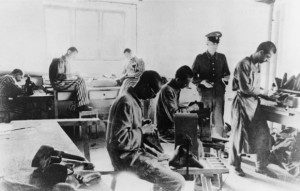Chapter 6 in Berlin at War discusses the labor force in the Third Reich. Many of which come from conquered lands, such as Poland, France, etc. These “foreign workers” were also known as forced laborers or even slave laborers. The process of being transported to camps was often long and cramped. Some camps were cleaner than others, but the overall conditions of the camps tended to be poor. One laborer described the situation as “the most humiliating and degrading experience” of their life.
In addition to overcrowding, food was limited. Food was assigned based on the type and the severity of the work. However, those arriving were not yet assigned jobs, so they were not entitled to any rations. Heavy labor was typically given to young men, but other tasks were assigned at random. Smaller business owners were given the option to select foreign laborers in person, which did not seem to make much of a difference because the laborers thought of themselves as “working for the enemy.”
The foreign workforce in Berlin topped 400,000 in 1943, which represented about 20% of the total. Of this number, 33% came from Western Europe and 33% were women. Not all foreign workers were treated equally, however. Racial distinctions were made, which affected both living and working conditions. Western foreign laborers were treated like employees and were given some freedom on weekends as well as a small wage. Eastern workers, on the other hand, were subject to legislation, limiting movements, freedom, rations, conditions, and wages. They were humiliated because they had to wear a cloth badge on their clothing.

As I read this chapter, I made the same parallel to American slavery in the South. Black people were usually subjected to poor working and living conditions, whereas whites were given better overall conditions. Race played a huge factor in the past. It was the difference between receiving a living wage and no wage at all. It was the difference between having sufficient food to eat and having marginal access to food. It was the difference between having a wardrobe and having one outfit to wear daily. Even though workers were not satisfied with the conditions, there was little they could do to change the situation. In the event of misbehavior, slave laborers (both in America and Nazi Germany) were subject to numerous penalties. They could be physically beaten, lose privileges, and lose rations.

In closing, Berliners tried to avoid foreign laborers by asking no questions and keeping their heads down. Ordinary Berliners were always worrying about their own survival, so they had little energy left to help the foreigners. Since there were so many foreign workers in Berlin, some people began to worry that they would eventually stab Germans in the back. However, most foreigners simply wanted to return home in order to live a normal life. Even though they were unwelcome by many, the foreign laborers were a necessary component for Nazi Germany to fight in WWII.
